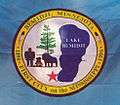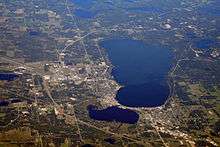Bemidji, Minnesota
| Bemidji, Minnesota | ||
|---|---|---|
| City | ||
|
Statues of Paul Bunyan and Babe the Blue Ox | ||
| ||
| Nickname(s): B-Town | ||
| Motto(s): "The First City On The Mississippi" | ||
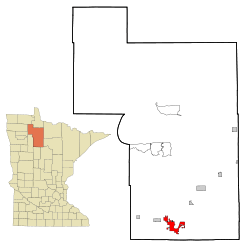 Location of the city of Bemidji within Beltrami County in the state of Minnesota | ||
 Bemidji Location in the United States | ||
| Coordinates: 47°28′25″N 94°52′49″W / 47.47361°N 94.88028°W | ||
| Country | United States | |
| State | Minnesota | |
| County | Beltrami | |
| Incorporated | 1896 | |
| Government | ||
| • Mayor | Rita Albrecht | |
| Area[1] | ||
| • City | 14.14 sq mi (36.62 km2) | |
| • Land | 12.92 sq mi (33.46 km2) | |
| • Water | 1.22 sq mi (3.16 km2) 8.63% | |
| Elevation | 1,365 ft (416 m) | |
| Population (2010)[2] | ||
| • City | 13,431 | |
| • Estimate (2016)[3] | 14,942 | |
| • Density | 950/sq mi (370/km2) | |
| • Urban | 14,500 (roughly) | |
| Time zone | UTC-6 (Central) | |
| • Summer (DST) | UTC-5 (Central) | |
| ZIP code | 56601 | |
| Area code(s) | 218 | |
| FIPS code | 27-05068 | |
| GNIS feature ID | 0655325[4] | |
| Website | www.ci.bemidji.mn.us | |
Bemidji (/bəˈmɪdʒiː/ bə-MIJ-ee) is a city in Beltrami County (and county seat[5]), in north west Minnesota, United States. According to the 2012–2016 American Community Survey 5-year estimates, the United States Census Bureau estimates the total population of Bemidji as of 2016 to be 14,664, making it the largest commercial center between Grand Forks, North Dakota and Duluth, Minnesota. Bemidji houses many Native American services, including the Indian Health Service. The city is the central hub of the Red Lake Indian Reservation, White Earth Indian Reservation and the Leech Lake Indian Reservation. Bemidji lies on the south west shore of Lake Bemidji, the northernmost lake feeding the Mississippi River and as such is deemed "The First City On The Mississippi." Bemidji is also the self-proclaimed "curling capital" of the U.S. and alleged birthplace of Paul Bunyan.
Etymology
Its name derives from the Ojibwe Buh-mid-ji-ga-maug (Double-Vowel orthography: bemijigamaag),[6] meaning "a lake with crossing waters". On occasion, in Ojibwe, the city of Bemidji is called Wabigamaang ("at the lake channel/narrows"), because part of the city is situated on the Lakes Bemidji/Irving narrows, located on the south end of Lake Bemidji, and extends to the eastern shore of Lake Irving. Some sources also credit the name to Chief Bemidji, an Ojibwe chief.[7]
History
Bemidji Township was surveyed in 1874 and organized in 1896 twenty-four days after the village of Bemidji was chartered and is the oldest township in the county. In 1897, the county attorney declared the original Bemidji township organization illegal (no reason given) and the township reorganized June 26, 1897.[8]
Beltrami was created on February 28, 1866, by an act of legislation.
About 50 Leech Lake Indians lived along the south shore of the lake prior to the 1880s. They called the lake Bemidjigumaug, meaning “river or route flowing crosswise”. Freeman and Besty Doud claimed 160 acres west of and including, what is present Diamond Point, and were Bemidji’s first homesteaders. The Porter Nye family soon followed them.
Art Lee created the story that the folkloric figure Paul Bunyan came from the Northwoods which then led to the creation of the statues of Paul Bunyan and Babe the Blue Ox. Per Discover America, the Paul and Babe statues are "the second most photographed statues in America" surpassed only by Mount Rushmore.[9] The Statue of Paul Bunyan was commissioned by the Bemidji’s Rotarians as another tourist attraction. It was unveiled January 15, 1937, to kick off a Winter Carnival that drew over ten thousand visitors.
John Steidl’s sawmill was located on the east bank of the Mississippi River, close to Carson’s Trading Post. Remore Hotel and Carl Carlson’s blacksmith shop were on the west side of the river. Bemidji was incorporated on May 20, 1896, and by that time there were three publishing companies, Alber Kaiser, The Bemidji Pioneer, and the Beltrami County News. William Bartleson's Stage and Express Service was created to carry mail between Bemidji and Park Rapids. He was advertised by Speelman’s Eagle, owned by Clarence Speelman, along with other stores. By 1898, railroads came to Bemidji and brought even more business. By 1900 the Village of Bemidji’s population had grown to 2,000.
Thomas Barlow Walker, John S. and Charles Pillsbury invested millions into timber in 1874, since beaver pelts were nearing depletion by the mid-1890s. Walker owned Red River Lumber Company of Crookston that claimed almost half of Beltrami County’s timber. He soon sold his sawmill and timber claim to Thomas Shevlin and Frank Hixon. Logging was done in the winter while sawmilling was done in the summer. Crookston opened 13 logging camps, which provided jobs and homes for lumberjacks. Between 1907 and 1910 were years that brought drought and local forest fires to northern Minnesota. Lumber production was Bemidji’s major industry, but because of a fire that occurred on July 19, 1914, a sawmill burned down causing disaster for business. It was later rebuilt. During the Great Depression of the 1930s, Bemidji’s business profited, providing food, materials, and services for the Civilian Conservation Corps and Youth Conservation Corps programs. However, during the war years lumber business stopped, but when men came back from war lumber business was booming, since many people needed homes.
By the 1870s, timber cruisers were already making forays into the great pine forests that surrounded Bemidji. They were seeking new timberlands for T.B. Walker, the Pillsburys, Henry Akeley, Charles Ruggles and Frederick Weyerhaeuser, the barons of the wood industry. Today Bemidji stands as an important educational, governmental, trade and medical center for north central Minnesota. The wood industry is still a significant part of the local economy with Georgia-Pacific, Potlatch and Northwood Panelboard all having waferboard plants in the local area, utilizing wood species that were once thought to be waste trees.[10]
Parks and recreation
Bemidji is near Chippewa National Forest, Itasca State Park, Lake Bemidji State Park, Big Bog State Recreation Area, and state forest areas. Bemidji has 400 lakes within 25 miles (40 km), 500 mi (800 km) of snowmobile trails and 99 mi (160 km) of cross country ski trails.
There is a Paul Bunyan State Trail that runs from Brainerd, MN, and Lake Bemidji State Park. The trail can be used for walking, biking, snowmobiling, and cross-country skiing.[11] There is also a bike trail around Lake Bemidji that is about 17 miles. There is an event every year where families and individuals bike around the lake with rest stops along the way.[12]
Art in the Park, hosted by Paul Bunyan Communications and Watermark Art Center is held every year in the Bemidji Library Park across from the Watermark Art Center. Art in the Park has been a summer highlight for the residents of Bemidji since 1967. Art in the Park features over 100 artists, food vendors, and live entertainment. They will sell anything from wood and ceramics, clothing and jewelry, photography, metalworking, greeting cards, homemade preserves, food, candles, soaps, and much more. The annual attendance rate is roughly 4,000 people.[13]
Every year, in the first week of August, teams compete in the Dragon boat races. The races are not the only thing that people can enjoy. There are also many food vendors, kid’s activities, music, cultural performances, and more. An interesting fact, dragon boat racing is currently the fastest growing water sport in the nation.[14]
The Bemidji Polar Days, also known as Winterfest, is a week-long festival that includes many different activities such as polar plunge, sled derby, broomball, and a 5k polar walk/run. Some other activities that can be found at the festival include curling, pond hockey, and a cornhole tournament.[15]
Bemidji is home to a couple more recreational events throughout the year. The Paul Bunyan Triathlon is the 3rd Saturday in August. The Minnesota Finlandia Ski Marathon is also held in Bemidji.[16]
Geography
According to the United States Census Bureau, the city has a total area of 14.14 square miles (36.62 km2), of which 12.92 square miles (33.46 km2) is land and 1.22 square miles (3.16 km2) is water.[1]
Four-lane U.S. Route 2, U.S. Route 71, and Minnesota State Highway 197 are three of the main routes in the city. Minnesota State Highways 89 and 371 are nearby.
The largest earthquake on record for the Bemidji area was recorded on September 3, 1917. It is claimed that it shook houses down in Bemidji and across northern Minnesota.[17] The epicenter was about 95 miles (153 km) away in Staples, Minnesota, and affected an area of 48,000 square kilometres (19,000 sq mi) with a magnitude 4.4 with a maximum intensity of VI to VII. The closest and most recent quake occurred in Walker, Minnesota, on September 27, 1982, with a magnitude of 2.0.[18]
Climate
Bemidji has a hemiboreal humid continental climate, Dfb in the Köppen climate classification: short, warm summers, and long, severe winters. The average mean annual temperature in Bemidji is 37.3 degrees Fahrenheit. The coldest month is January with an average daily high of 16 degrees and an average daily low of −4 degrees. The warmest month is July with an average daily high of 79 degrees and an average daily low of 57 degrees. The average annual humidity is 47%. The average annual snowfall is 41.1 inches and the average annual rainfall is 23.8 inches. The average day Lake Bemidji freezes over is November 26 and the average day the ice goes off the lake is April 26.
| Climate data for Bemidji, Minnesota 1981–2010 Normals, snowfall 1987–2018 | |||||||||||||
|---|---|---|---|---|---|---|---|---|---|---|---|---|---|
| Month | Jan | Feb | Mar | Apr | May | Jun | Jul | Aug | Sep | Oct | Nov | Dec | Year |
| Record high °F (°C) | 52 (11) |
60 (16) |
72 (22) |
95 (35) |
94 (34) |
94 (34) |
101 (38) |
101 (38) |
98 (37) |
95 (35) |
73 (23) |
56 (13) |
101 (38) |
| Average high °F (°C) | 16.3 (−8.7) |
22.9 (−5.1) |
34.6 (1.4) |
50.8 (10.4) |
64.5 (18.1) |
72.9 (22.7) |
77.4 (25.2) |
75.2 (24) |
65.5 (18.6) |
51.6 (10.9) |
34.4 (1.3) |
20.3 (−6.5) |
49.0 (9.4) |
| Daily mean °F (°C) | 5.9 (−14.5) |
11.2 (−11.6) |
24.2 (−4.3) |
39.1 (3.9) |
53.1 (11.7) |
62.6 (17) |
67.2 (19.6) |
64.7 (18.2) |
55.1 (12.8) |
41.9 (5.5) |
26.1 (−3.3) |
11.5 (−11.4) |
38.6 (3.7) |
| Average low °F (°C) | −4.6 (−20.3) |
−0.4 (−18) |
13.7 (−10.2) |
27.4 (−2.6) |
41.7 (5.4) |
52.3 (11.3) |
57.0 (13.9) |
54.2 (12.3) |
44.7 (7.1) |
32.2 (0.1) |
17.8 (−7.9) |
2.7 (−16.3) |
28.4 (−2) |
| Record low °F (°C) | −50 (−46) |
−47 (−44) |
−44 (−42) |
−13 (−25) |
11 (−12) |
24 (−4) |
37 (3) |
30 (−1) |
22 (−6) |
2 (−17) |
−30 (−34) |
−45 (−43) |
−50 (−46) |
| Average precipitation inches (mm) | 0.73 (18.5) |
0.66 (16.8) |
1.09 (27.7) |
1.78 (45.2) |
3.05 (77.5) |
4.38 (111.3) |
3.95 (100.3) |
3.21 (81.5) |
3.10 (78.7) |
2.54 (64.5) |
1.35 (34.3) |
0.79 (20.1) |
26.63 (676.4) |
| Average snowfall inches (cm) | 10.7 (27.2) |
7.9 (20.1) |
6.8 (17.3) |
4.8 (12.2) |
0.7 (1.8) |
0 (0) |
0 (0) |
0 (0) |
0.1 (0.3) |
1.7 (4.3) |
6.1 (15.5) |
7.9 (20.1) |
46.7 (118.8) |
| Source #1: Climatography of the United States[19] | |||||||||||||
| Source #2: XMACIS[20] | |||||||||||||
Demographics
| Historical population | |||
|---|---|---|---|
| Census | Pop. | %± | |
| 1900 | 2,183 | — | |
| 1910 | 5,099 | 133.6% | |
| 1920 | 7,086 | 39.0% | |
| 1930 | 7,202 | 1.6% | |
| 1940 | 9,427 | 30.9% | |
| 1950 | 10,001 | 6.1% | |
| 1960 | 9,958 | −0.4% | |
| 1970 | 11,490 | 15.4% | |
| 1980 | 10,949 | −4.7% | |
| 1990 | 11,245 | 2.7% | |
| 2000 | 11,917 | 6.0% | |
| 2010 | 13,431 | 12.7% | |
| Est. 2016 | 14,664 | [3] | 9.2% |
| U.S. Decennial Census[21] 2015 Estimate[22] | |||
2010 census
As of the census[2] of 2010, there were 13,431 people, 5,339 households, and 2,557 families residing in the city. The population density was 1,039.6 inhabitants per square mile (401.4/km2). There were 5,748 housing units at an average density of 444.9 per square mile (171.8/km2). The racial makeup of the city was 81.3% White, 1.2% African American, 11.3% Native American, 1.4% Asian, 0.1% Pacific Islander, 0.3% from other races, and 4.4% from two or more races. Hispanic or Latino of any race were 1.9% of the population.
There were 5,339 households of which 24.9% had children under the age of 18 living with them, 28.7% were married couples living together, 14.4% had a female householder with no husband present, 4.8% had a male householder with no wife present, and 52.1% were non-families. 38.6% of all households were made up of individuals and 16.7% had someone living alone who was 65 years of age or older. The average household size was 2.18 and the average family size was 2.83.
The median age in the city was 27.1 years. 19.4% of residents were under the age of 18; 26.7% were between the ages of 18 and 24; 21.6% were from 25 to 44; 17.5% were from 45 to 64; and 14.8% were 65 years of age or older. The gender makeup of the city was 47.7% male and 52.3% female.
2000 census
As of the census of 2000, there were 11,917 people, 4,669 households, and 2,427 families residing in the city. The population density was 1,011.8 people per square mile (390.6/km²). There were 4,948 housing units at an average density of 420.1 per square mile (162.2/km²). The racial makeup of the city was 84.31% White American, 0.76% African American, 11.52% Native American, 1.12% Asian, 0.03% Pacific Islander, 0.20% from other races, and 2.06% from two or more races. Hispanic or Latino of any race were 1.14% of the population.
There were 4,669 households out of which 25.9% had children under the age of 18 living with them, 34.0% were married couples living together, 14.7% had a female householder with no husband present, and 48.0% were non-families. 35.9% of all households were made up of individuals and 15.0% had someone living alone who was 65 years of age or older. The average household size was 2.22 and the average family size was 2.87.
In the city, the population was spread out with 21.2% under the age of 18, 24.9% from 18 to 24, 23.0% from 25 to 44, 15.4% from 45 to 64, and 15.6% who were 65 years of age or older. The median age was 28 years. For every 100 females, there were 87.1 males. For every 100 females age 18 and over, there were 83.0 males.
The median income for a household in the city was $28,072, and the median income for a family was $37,250. Males had a median income of $28,312 versus $20,694 for females. The per capita income for the city was $15,264. About 13.2% of families and 19.2% of the population were below the poverty line, including 19.7% of those under age 18 and 10.9% of those age 65 or over.
Economy
| Industries | Number of Employees |
|---|---|
| Healthcare and social assistance | 6,782 |
| Retail Trade | 2,669 |
| Accommodation and food services | 1,327 |
| Professional, scientific, and technical services | 760 |
| Other services (except public administrations) | 550 |
| Finance and insurance | 351 |
| Information | 343 |
| Wholesale trade | 335 |
| Transportation and warehousing | 222 |
| Arts, entertainment, and reaction | 165 |
| Manufacturing | 149 |
| Administrative and support and waste management and remediation services | 130 |
| Educational services | 109 |
| Utilities | 93 |
| Real estate and rental and leasing | 60 |
These are the top 15 industries in Bemidji. On the United States Census Bureau American Factfinder, some industries had a range of employees, so the average number of employees were used. Also, some industries such as healthcare and social assistance, professional, scientific, and technical services, other services, arts, entertainment, and reaction, and educational services were split into three different categories. The number of employees for the three categories was combined into one category.[23]
Government
| Mayor | Rita Albrecht |
| Council Ward 1 | Michael Meehlhause |
| Council Ward 2 | Roger Hellquist |
| Council Ward 3 | Ron Johnson |
| Council Ward 4 | Richard Lehmann |
| Council Ward 5 | Nancy Erickson |
| Council at-large | Dave Larson |
Bemidji's government is made up of a mayor and a council, with at least 5 council wards.[24]
Culture
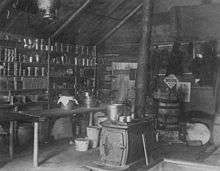
Bemidji is a college city with strong arts influences. The city's streets are lined with small shops and adorned with sculptures and other forms of public art.
The Concordia Language Villages are located near Bemidji and have been influential in the existence of several language conversational groups (including French, Chinese, Norwegian, Spanish, Italian, and German) that meet weekly in local coffee houses. An article written and published in the Bemidji Pioneer in 2018 states the Concordia’s Korean Language Village received a five million dollar grant. The Korean village is the newest addition to the Concordia Language Villages.[26]
In 2011, Red Lake Ojibwe Nation Chairman Floyd Jourdain Jr. complimented the city for its Ojibwe language signage in places of business.[27]
During the summer, the Paul Bunyan Playhouse operates a non-Equity, summer stock theater at the Chief Theater.[28] In the same venue, Bemidji Community Theatre also provides live theatre for the Bemidji area when Paul Bunyan Playhouse is not in operation.[29]
The statues of Paul Bunyan and Babe the Blue Ox are a popular tourist spot in Bemidji, with many people photographing themselves in front of them. The statues are right next to the Bemidji Tourist Information Center, where tourists can get information on activities, events, and attractions. The center also includes many artifacts of the lumberjack’s legend. One cool thing that the information center has is a giant book that you can sign your name in; the names go back a long time. Finally, there is an ancient fireplace that was built with 900 stones from every state in the United States, most of every Canadian province, and Minnesota national parks.[30]
As of 2016, according to Areavibes, the overall crime rate in Bemidji is 212% higher than the average of crimes in Minnesota and 161% higher than the national average. Violent crimes in Bemidji are 102% higher than the Minnesota average and 27% higher than the national average. Property crimes in Bemidji are 225% higher than the Minnesota average and 182% higher than the national average.[31]
Sports
The city is well known to fans of the sport of hockey. As a Division II team, Bemidji State was a hockey dynasty in the 80s and 90s. Bemidji was in the title game 8 straight years, winning 5 Div II titles. They then switched from a Division II team to a Division I team in 1999 and are still currently a Division I team. They have not won any division I titles.
Also, the city is known to fans of the sport of curling. Both men's and women's rinks from the Bemidji Curling Club won the right to represent the United States in the 2005 World Curling Championship and the 2006 Winter Olympics in Torino, Italy. Pete Fenson, the skip of the U.S. curling team that took the bronze medal at the 2006 Olympics, is a native of Bemidji, as is Natalie Nicholson, who was the lead for the United States women's team at the 2010 Winter Olympics in Vancouver.
A city referendum for a Bemidji Regional Events Center passed by a slim majority of 43 votes out of 4,583 votes cast in November 2006. Opening in 2010, the center was renamed the Sanford Center and serves as home to the Bemidji State University hockey team. The men's and women's hockey teams are both members of the Western Collegiate Hockey Association. Beginning in the spring of 2014, the Sanford Center is the home of the city's first-ever professional sports team, the Minnesota Axemen of the Indoor Football League. They were terminated after the 2015 season.[32]
Education
Bemidji is home to Bemidji State University, Northwest Technical College, and Oak Hills Christian College. Public Education is served by Bemidji Area Schools is a part of the Independent School District 31 that includes 8 elementary schools, 1 middle school, and 1 high school. The rest of their public education schools include TrekNorth Charter High School, Voyagers Charter High School and Schoolcraft Charter School. Bemidji is also home to three private schools: St. Philips Catholic School, St. Mark's Lutheran School and Heartland Christian Academy.
Regional center
The City of Bemidji acts as a regional center for shopping, arts, entertainment, education, health services, worship, and government services. The Bemidji Area includes parts or all of Beltrami (Pop. 44,442), Hubbard (Pop. 20,428), Cass (Pop. 28,567), Itasca (Pop. 45,058), Koochiching (Pop. 13,311), Lake Of The Woods (Pop. 4,045), Marshall (Pop. 9,439), Pennington (Pop. 13,930), Red Lake (Pop. 4,089), Clearwater (Pop. 8,695), and Mahnomen (Pop. 5,413) counties. The Bemidji area also includes the White Earth (Pop. 9,192) and Leech Lake (Pop. 10,660) Reservations and the Sovereign Nation of Red Lake (Pop. 5,162). The marketing firm Lexington Realty International places the Bemidji Area population at 131,553.[33] The US Census Bureau places the poplulation of the Bemidji Micropolitan Statistical area at 45,644. [34]
Media
Newspapers
The Bemidji Pioneer is the local daily (except Mondays) newspaper.[35] Now owned by Forum Communications Company, it was founded as a weekly in 1896.[36]
TV stations
Most of Bemidji's TV stations primarily rebroadcast the television stations of the Twin Cities.
| Channel | Digital Channel | Call sign | Affiliation | Owner |
|---|---|---|---|---|
| 9 | 9 | KAWE | PBS | Northern MN Public TV |
| 12 | 12 | KCCW (Located near Walker, MN) | CBS (WCCO-TV relay) | CBS Corporation |
| 26 | 26 | KFTC | MyNetworkTV (WFTC relay) | Fox Television Stations |
| 28 | none | K28DD | ABC (KSAX translator) | Hubbard Broadcasting |
| 30 | none | K30DK | Fox (KMSP translator) | Fox Television Stations |
| 42 | none | K42FH | TBN | Trinity Broadcasting Network |
| 48 | 48* | K48KI | 3ABN | Three Angels Broadcasting Network |
Radio stations
FM
AM
| AM radio stations | ||||
|---|---|---|---|---|
| 820 AM | WBKK | AM 820 | Catholic Talk | Real Presence Radio |
| 1300 AM | KPMI | County Legends | Classic Country | Paskvan Media |
| 1360 AM | KKBJ | Talkradio 1360 | News/Talk | RP Broadcasting |
| 1450 AM | KBUN | The Bun | Sports (KFAN/ESPN programming) | Paul Bunyan Broadcasting |
Magazines
- inBemidji, a quarterly lifestyle magazine focused on Bemidji and the surrounding area. First published in December 2013 (as inMagazine) by The Bemidji Pioneer.[37]
- Northwoods Woman, a bimonthly magazine published from 2008–2013, launched in Bemidji, Walker and Park Rapids and included articles about women who live and work in northern Minnesota.[38]
Infrastructure
Major highways
The following routes are located in the Bemidji area.
Air service
Bemidji is served by Bemidji Airport, which has passenger services on 3 airlines, Delta Connection, Sun Country Airlines and Bemidji Airlines, the latter of which is based in the city of Bemidji. Bemidji Airlines also operates cargo flights, while Corporate Air is the only airline to operate all-cargo-only flights to the airport, on behalf of FedEx Express.
Banks
- Wells Fargo
- First National Bank of Bemidji
- Security Bank USA
- Deerwood Bank
- Bank Forward
- Affinity Plus Federal Credit Union
- Ultima Bank Minnesota
- Trustar Federal Credit Union
- Citizens State Bank – Midwest
- Riverwood Bank
- Bemidji Holding Co
- Trustar Federal Credit Union
- Minnesota Finance
Notable people
- Roy C. Booth, speculative fiction, fantasy and horror author.
- Cade Bittner, actor, starred in A Beautiful Day
- Gary Burger, guitarist and lead vocalist for the band The Monks
- Dave Casper, Hall of Fame football player
- Pete Fenson, American curling skip
- Terry Frost, actor, starred in The Monster Maker
- Brian Hickerson, baseball player, pitched in the major leagues from 1991–1995
- Bob A. Johnson, Minnesota state representative and school social worker
- Joe Motzko, hockey player, member of 2007 Stanley Cup champion Anaheim Ducks
- Kent Nerburn, author
- Jane Russell, actress[39]
- Gary Sargent, Pro Ice Hockey defensemen, played in National Hockey League 1975–1983
- Drew Starlin, actor, starred in Mr. Monk and the Bird and the Bees
- Will Weaver, creative writing teacher at Bemidji State University. He is the author of Read Earth, White Earth, and A Grave Stone Made of Wheat.
In popular culture
The first season of the FX TV series Fargo, starring Billy Bob Thornton and Martin Freeman, is mainly set in and around Bemidji and Duluth.[40] The series, however, was filmed in Calgary, Alberta.
In "How I Met Your Mother" S4E11 "Little Minnesota" Robin claims she's from Bemidji, so as not to get kicked out of a Minnesota themed bar to which Marshall takes her.
Gallery
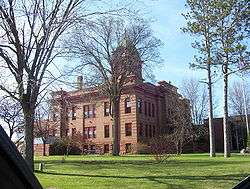 Courthouse
Courthouse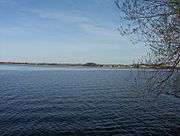 Lake Bemidji
Lake Bemidji
References
- 1 2 "US Gazetteer files 2010". United States Census Bureau. Archived from the original on 2012-07-14. Retrieved 2012-11-13.
- 1 2 "American FactFinder". United States Census Bureau. Retrieved 2012-11-13.
- 1 2 "Population and Housing Unit Estimates". Retrieved June 9, 2017.
- ↑ "US Board on Geographic Names". United States Geological Survey. 2007-10-25. Retrieved 2008-01-31.
- ↑ "Find a County". National Association of Counties. Archived from the original on 2011-05-31. Retrieved 2011-06-07.
- ↑ "Freelang Ojibwe Dictionary". Beaumont. 2012. Retrieved 1 November 2012.
- ↑ Upham, Warren (1920). Minnesota Geographic Names: Their Origin and Historic Significance. Minnesota Historical Society. p. 36.
- ↑ "History". Bemidji Township.
- ↑ "Discover America – Paul Bunyan and Babe the Blue Ox". Discover America. Archived from the original on 5 October 2011.
- ↑ "Bemidji Minnesota History". A Guide to Minnesota Communities. Retrieved 26 April 2018.
- ↑ "Paul Bunyan State Trail". TrailLink. Rails-to-Trails Conservancy. Retrieved 26 April 2018.
- ↑ "Biking". Visit Bemidji Minnesota. Retrieved 26 April 2018.
- ↑ "Art in the Park". Watermark Art Center. Retrieved 26 April 2018.
- ↑ "Lake Bemidji Dragon Boat Festival". Visit Bemidji Minnesota. Retrieved 26 April 2018.
- ↑ "Winterfest on Lake Bemidji". Bemidji Chamber. Bemidji Area Chamber of Commerce. Retrieved 26 April 2018.
- ↑ "Home of the Minnesota Finalndia". Minnesota Finlandia Community Health Sports. Retrieved 1 November 2012.
- ↑ "Earthquake Shakes City". Little Falls Daily Transcript. September 4, 1917.
- ↑ "Minnesota at a Glance: Earthquakes in Minnesota" (PDF). Regents of the University of Minnesota. 1994.
- ↑ "Monthly Average of Daily Maximum and Minimum Temperature" (PDF). National Climatic Data Center.
- ↑ "Monthly Climate Normals (1981–2010) – BEMIDJI, MN". National Climatic Data Center.
- ↑ United States Census Bureau. "Census of Population and Housing". Archived from the original on May 12, 2015. Retrieved September 11, 2013.
- ↑ "Population Estimates". United States Census Bureau. Archived from the original on October 19, 2016. Retrieved June 17, 2016.
- ↑ "2012 Economic Census of the United States". American Fact Finder. United States Census Bureau. Retrieved 26 April 2018.
- ↑ "Bemidji City Council". City of Bemidji First City on the Mississippi. Retrieved 26 April 2018.
- ↑ Amble, Rosemary Given. "Bemidji Minnesota History: Original Inhabitants Meet White Settlers". LakesnWoods.com. Retrieved 1 November 2012.
- ↑ Hyatt, Kim (2 April 2018). "Global handbag king hands $5 million donation to Concordia's Korean Language Village". Retrieved 26 April 2018.
- ↑ Meurs, Michael (2011-09-21). "Native American Language Revitalization on Red Lake Agenda". Indian Country Today Media Network. Retrieved 2013-04-13.
- ↑ "History of the Chief Theater". thechieftheater.com. Retrieved 21 July 2018.
- ↑ "The BCT Story". bemidjicommunitytheater.org. Retrieved 21 July 2018.
- ↑ "Bemidji Tourist Information Center". Visit Bemidji Minnesota. Retrieved 26 April 2018.
- ↑ "Bemidji Minnesota Crime". AreaVibes. Retrieved 26 April 2018.
- ↑ http://www.bemidjipioneer.com/sports/3890871-indoor-football-axemen-axed-ifl
- ↑ http://www.lexingtonco.com//images/files/67/Demographics.pdf
- ↑ https://mn.gov/deed/newscenter/publications/review/september-2015/micropolitans.jsp
- ↑ "Pioneer Web Site". Bemidji Pioneer and Forum Communications Company. Retrieved 1 November 2012.
- ↑ https://chroniclingamerica.loc.gov/lccn/sn90059048/
- ↑ "inMagazine".
- ↑ "Northwood Woman". Archived from the original on 16 April 2013. Retrieved 1 November 2012.
- ↑ Wilson, Earl (Nov 27, 1969). "Small Towns Have Produced Many Big Stars". The Milwaukee Sentinel. pp. A33. Retrieved 22 May 2015.
- ↑ Joe Froemming, "Bemidji is 'Fargo': From characters large and small to the town itself, a fictional Bemidji plays a large role in new, much-anticipated FX television series," Bemidji Pioneer, April 18, 2014, http://www.bemidjipioneer.com/content/bemidji-fargo-characters-large-and-small-town-itself-fictional-bemidji-plays-large-role-new, accessed March 7, 2017.
External links
| Wikimedia Commons has media related to Bemidji, Minnesota. |
- City of Bemidji
- Bemidji Area Chamber of Commerce
- The Bemidji Pioneer, newspaper
- Sanford Bemidji Medical Center
- Best of Bemidji Quarterly Magazine
- 360 Degree Virtual Tour of 2011 Beltrami County Fair
- First National Bank of Bemidji
Coordinates: 47°28′25″N 94°52′49″W / 47.47361°N 94.88028°W
